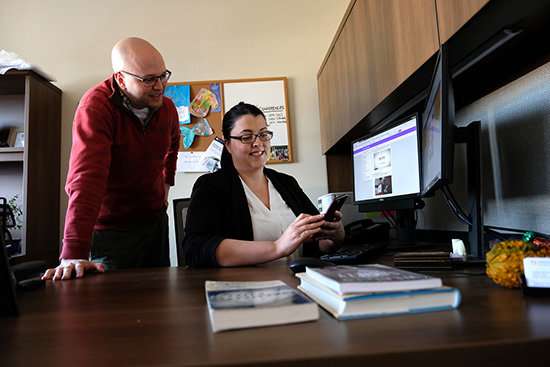Crisis informatics lab tracks extreme weather on social media

With the growth of online and mobile technologies, social media has emerged as a powerful tool for sharing information during extreme weather events.
Just last month, Hurricane Florence went viral as it pummeled the Carolinas. People who rode out the storm turned to platforms like Facebook, Twitter and YouTube to share photos and videos from the ground. Others were simply using social media for forecast and evacuation updates, as well as to stay in contact with impacted family and friends.
The online chatter had Amber Silver's full attention.
Crisis Informatics Lab
Silver, an assistant professor at the College of Emergency Preparedness, Homeland Security and Cybersecurity, established the Crisis Informatics Lab on campus to research the usage of social media around disasters.
Launched this month, Silver is the lab's principal investigator, working in collaboration with CEHC colleague Sam Jackson, a newly hired assistant professor who studies politics and activism online in the United States.
The lab's primary focus is extreme weather events.
"Social media is a powerful tool. It gives us all a platform to be our own news creators," said Silver. "We are focused on what motivates people to share information about extreme weather. Also, if sharing this information influences decision making, in the days leading up, during and after the storm passes."
"I am deeply passionate about weather and risk communication – our lab is combining both," she added.
Silver credits Hurricane Sandy in 2013 as the first time Twitter was used by first responders to communicate with people who were in need of assistance. Even before the storm hit, local officials were turning to digital platforms to share information in real-time.
Last August, Twitter once again became a life-saving tool as Hurricane Harvey flooded Texas. First responders located people in need of rescue through the hashtag #HarveySOS.
There's value after the storm passes too, according to Silver.
"People are turning to social media to connect with others who have gone through a similar experience to them," Silver said. "Some find it soothing to share their story. It's a way of healing."
Credibility is something Silver is observing closely.
"Trust on social media is very person-dependent," Silver said. "Some people will only follow official accounts, while others have a general distrust for government and the news media. It's important for community leaders to be good stewards and moderate the conversation."
Florence Tweets
To understand Twitter's usage around Hurricane Florence, Silver, through the Crisis Informatics Lab, used keyword searches to collect tweets from 6 million accounts that made mention of the storm.
Accounts located in the Carolinas, Virginia, Georgia and Florida received an at-mention from the lab with a link to a brief questionnaire. Silver hopes to collect and interpret responses within the next few months.
"Our goal is make practical recommendations that will improve the effectiveness of social media communication during crisis situations; this questionnaire is going to provide us with some valuable insight," Silver said.
Provided by University at Albany





















